« Features
PhD in Philosophy for Artists: A Conversation with George Smith
George Smith has long been a leader and innovator in North American education. Dr. Smith is the founder and president of the Institute for Doctoral Studies in the Visual Arts (IDSVA). Founded in 2007, IDSVA is the first and only school in the world to offer a PhD in philosophy for visual artists, curators, and creative scholars. Supported by a worldwide faculty of renowned scholars and artists, IDSVA offers low-residency, multi-media digital instruction; holds residency intensives; and conducts field work in Rome, Spannocchia Castle (Tuscany), Siena, Florence, Berlin, Venice, Paris, Istanbul, New York City, and at Brown University.
By Stephen Knudsen
Stephen Knudsen-In the last issue of ARTPULSE, James Elkins informed us that there are now 152 PhD programs for artists worldwide, with seven now in the United States and more in the pipeline.1 The Institute of Doctoral Studies in the Visual Arts (IDSVA) is on the list. Could you give us a little history on IDSVA and how your PhD program differs from other programs listed by Elkins?
George Smith-Thanks for having me, Stephen. I’m delighted to talk with you: but first, another thanks to James Elkins. The PhD for artists marks a monumental development in the history of graduate education worldwide, and James is the one prominent scholar tracking this ongoing event as a major global phenomenon. We owe him a big, mostly unrecognized, debt of gratitude. When the likes of Foucault take up the PhD for artists as cultural history, James Elkins will come at the top of the acknowledgements.
As for a little background on The Institute for Doctoral Studies in the Visual Arts, art is the concrete representation of philosophical abstractions, and so it follows that the artist is, by nature and by definition, a philosopher. Even so, there never was a place in the world, a school, that said to the holder of an MFA, “If you want a PhD in philosophy, you needn’t go back and take a master’s in philosophy. We recognize your MFA as substantiation of intellectual/scholarly talent as it comes out of art as philosophy. You can study here; you can write your dissertation and take your doctorate in philosophy with us.” IDSVA is that school.
And there you have the main difference between IDSVA and the other PhDs and doctoral programs that James Elkins includes on his ever-longer list. While those programs are studio-based, or at least offer an extensive studio component, IDSVA has no studio curriculum whatever. It is the world’s only PhD in philosophy designed especially for artists. True, there are now a few PhD programs in the humanities that do recognize the MFA for credit, but as far as I know, IDSVA remains the only one in the world for artists.
By the word “artist” we mean, by the way, creative thinkers of many stripes, including architects, curators, and scholars who see their work as grounded in the expression of creative imagination in transdisciplinary contact with art and the world of ideas. And note here that I did not say willy-nilly or loosey-goosey expression. The IDSVA course of study is notoriously rigorous, certainly one of the toughest in the U.S.
S.K.-There have been skeptics along the way, yes?
G.S.-People are skeptical, especially about new ideas. In so many words some ask, “How can this be for real? How does one go about designing the world’s first PhD in philosophy for the artist? Who do you think you’re kidding?” I did not “design” IDSVA. Over a couple of long winter months I sat by the fire, dreaming. And I promised myself that whatever I dreamt up would be the school-its curriculum, its course of study, its program, its structure and mission-and that if at any point somebody said you can’t do this part or that part, I would give up the whole.
The miracle is that nowhere along the way did anybody say, “You can’t do this, or that.” Nor did I worry about money. There was no money. I dreamed up the school as if our resources were limitless. And it has all come true, even the money part. I want to stress this part of IDSVA’s founding because I think a big problem with education today is that everybody is worrying and planning and counting, and nobody is dreaming. That’s not to say that planning and worry and money are anything less than imperative. They just don’t come first.
Anyhow, here are the main parts of my dream:
- A world-class PhD in philosophy for artists, for the training of artist-philosophers
- A globalized education as experience (Topological Studies)
- An inspiring, world-wide faculty of unparalleled distinction
- No campus-put the savings not in profits but in students
- A digital-ed program that theorizes the possible relationship between modern technology and philosophy of education as an historical construct.
A logician or an academic administrator would say my list comprises apples and oranges. Yes, but this is a dream, and dreams don’t care about logic; they want to tell us about the human spirit. As I shared my dream with philosophers and artists, and most especially with students, it took on new contours, new shapes and structures, new possibilities. Now the dream was no longer mine; it was held in common, and from then on IDSVA has evolved across a history of its own becoming.
One of our students came up with a slogan that says it much better: “IDSVA is not a school; it’s a movement!” And I should not fail to mention that as I started this project, I was (and remain) a relative nobody; and yet amazing people from around the world, James Elkins among them, began to show up (seemingly out of nowhere) to lend a hand. Such is the power of dreams.
Of the parts of the dream I listed, let me elaborate on a couple. First is the notion of topology. In his interpretation of dreams, Freud found out that they’re made up of strata, archaeological layers covering over the histories of psychic life. To me, Freud was also talking about interpreting the relations between places and times, images and ideas, and the history of the cultural unconscious.
S.K.-So what do those dreams look like now, realized on ground?
G.S.-Concerning the IDSVA Topological Studies program, IDSVA students begin their studies in Rome, where they stand among the Classical ruins and think about Lucretius and Cicero. From there, they decamp to Spannocchia, a restored eleven-hundred acre feudal castle in Tuscany, where they hang out in the poppy fields with Cinta Senese piglets and wander the forest roads and feudal hallways; climb the tower; and talk about Agamben and Croce, courtly aesthetics, and Peggy Phelan.
From here, they do field work in Siena, the walled city of Medieval banking; the fabled Piazza Del Campo, Duccio and Lorenzetti; and then to Florence and the Uffizi of the Renaissance. Pushing toward the Neoclassical, students travel to Berlin, and from there to the Venice Biennale and the streets and bridges of the Baroque; then on to bourgeois Paris; and then to post-industrial New York; and finally, to Istanbul: the transhistorical East/West go-between.
And to bring in another part of the dream, imagine that in each of these places, each of these “chrono-topological” sites, you and your fellow students talk about the stratification of time and place, art and ideas, history and the cultural unconscious with some of the world’s greatest living philosophers and artists. To suggest how that possibility has played out, let me mention, for instance, Stephen Greenblatt, inventor of New Historicism, coming to Spannocchia Castle and taking breakfast, lunch, and dinner with us as well as lecturing on the transition from feudal to Renaissance consciousness. With Leonardo and Shakespeare as his players, and the castle as his backdrop, he was asking how, as revealed in the aesthetic representation of light, we humans became modern.
After the lectures, we took a train to Milan and stood together in front of Leonardo’s luminescent Last Supper, asking of one another Stephen’s question again. Then we boarded a plane for Paris, where France’s pre-eminent Marxian philosopher, Étienne Balibar, stepped onto the stage, telling us he would pick up where Stephen left off and trace the history of light from Siena and Milan to the Industrial Revolution and to the advent of modernism and Renzo Piano’s translucent postmodern Centre Pompidou. Speaking of Freud and dreams, this summer in Paris we will hear from the great psychoanalytic philosopher, Jacqueline Rose.
S.K.-James Elkins, in our interview, expressed a wish for institutions to print a philosophical blurb of substance on their programs. He said, “It has occurred to me that the studio-art PhD-and the MFA!-would be much more interesting if individual institutions put their strengths, weaknesses, and philosophies into print. Imagine reading ‘The New School of Art in Atlantic City emphasizes post-Pop, East-coast realism mixed with Yale-style abstraction. We teach theory, but mainly Lacan and Rancière.’ But of course institutions will never advertise themselves in those ways.”
May I put you on the spot and ask you for your blurb on IDSVA, and then could you break it down in detail?
G.S.-I don’t know that I can give you a good blurb, but I can borrow one from James Elkins, who says that IDSVA is “unique in the world” (Artists with PhDs). As I’ve said already, that is because IDSVA offers the world’s only PhD in philosophy for visual artists.
Nor do I mind saying again that we are also the first PhD program in the world that takes you from place to place, so that you can put together an archaeology of art and ideas of your own making, based on the experience of “being there.”
As I write this, we’re in residency in New York City, where students are presenting independent studies papers, conducting field work in galleries and museums, and working with artists and philosophers based in New York and from around the world.
In itself, that’s no big deal-plenty of schools do that kind of thing. What is a big deal is that the New York residency is connected to the other international sites I mentioned, and that all of these are interconnected in terms of the history of ideas and visual culture.
Another big distinction-and this I am particularly proud of-is the fact that IDSVA is probably the only world-class humanities PhD for people who don’t want to give up their jobs to do a PhD. IDSVA is designed primarily for artists and creative thinkers who teach. Our residency intensives are scheduled during summer and semester breaks, and the digital-ed part goes on during evenings and weekends in the fall and spring semesters.
As for how the IDSVA curriculum is different from other PhD programs, we are doggedly upfront and open: you can see an extensive program overview, the course descriptions, and all the course syllabi posted plain as day on our website. For the moment, let me say our readings, discussions, and critical writing and interventions range across the history of ideas in relation to the history of art and visual culture. We cover Classical art and the pre-Socratics all the way through to Judith Butler and what’s showing at the Harlem Studio Museum this very day.
And sure, we deal with so-called theory as much as philosophy; although, we don’t fuss about the difference. Nor do we go about things in the sequential order, partly because that ordering of things tends toward a hierarchical structure founded on the patriarchal origins of Greek thought. Ours is an elliptical approach. We start with the 20th century, move back to the 18th century, forward to the 21st, then in the third year back to the Classical, and so on.
In addition to being nomadic in our topological studies, we are rhizomatic in our independent studies. Independent studies take off and spread out in all kinds of directions that lead students far and away from the seminar and topological studies programs, both of which are more or less Eurocentric in focus. And these independent studies are presented as formal papers at residencies, so in this respect every residency is like a world-conference in the history of art and ideas, spanning for instance the intertextual relations between ancient American tribal art and New York Happenings, Miley Cyrus, contemporary Nicaraguan feminist documentary, globalization of aesthetics and the Venice Biennale, and the non-indexical nature of photography.
The independent studies and the seminars and are meant to fold in with the topological studies’ experience in such a way as to draw students toward a field interest and an area of focus that leads to the dissertation. The dissertation we expect to be completed in two years, but you can take longer if you need to.
I should also mention that IDSVA students do a third-year residency at Brown University, where Brown’s former dean, Paul Armstrong, conducts an intensive dissertation orientation. Paul’s daughter went to RISD, so he cares a lot about how the artist thinks and he’s deeply committed to the artist’s right to have a place like IDSVA.
S.K.-There’s a whole laundry list used by naysayers. Here is a big one: the PhD will un-necessarily keep artists in an ivory tower until they’re thirty-years-old with huge research loads and a dissertation of 60,000 to 200,000 words. What are your thoughts on that objection?
G.S.-Let me answer this question as it applies to IDSVA. In the first place, the average age of IDSVA students is around 45. They are mostly mid-career artists who teach in college and university art departments. About half are tenured or tenure track. So in one sense, the IDSVA PhD is no different from any other humanities PhD: it is designed for people who want to teach or advance their curatorial practice.
The big difference is that most of our students are already teaching, so we’re not producing PhD’s for the unemployment lines. I should quickly add, though, that about a third of our students are adjuncts. For them, the big plus is that when they go into the job market they bring with them two terminal degrees, not one.

IDSVA at 2013 Venice Biennale American Pavilion with Holly Block, Sarah Sze exhibition co-commissioner. Photo: Brittany Olsen
As for huge research loads and the dissertation: in the first year our students find it hard to get into the studio; by the second year they find their way back more regularly; and by the third, more regularly still. IDSVA dissertations average 80,000 words, and that project cuts into studio time, too.
Nevertheless, long before students complete the dissertation, they find that their studio practice has changed-and much for the better. Why? Not because they have learned to make marks better, but because they have learned to see the world better-in most cases, much better.
And let me add a word about those of our students who do not intend to teach. Some come for the sole purpose of making themselves better artists and others to develop their professional careers in the art world. The former take more time in the studio; the latter we support in various ways. One is co-chairing a symposium at Christie’s this Friday on “Mapping the Global Art Economy”; another has been introduced to and worked with world-leading curators; still another wants to become a theorist of fashion and is in Paris writing her dissertation on Bill Cunningham and the democratization of haute couture.
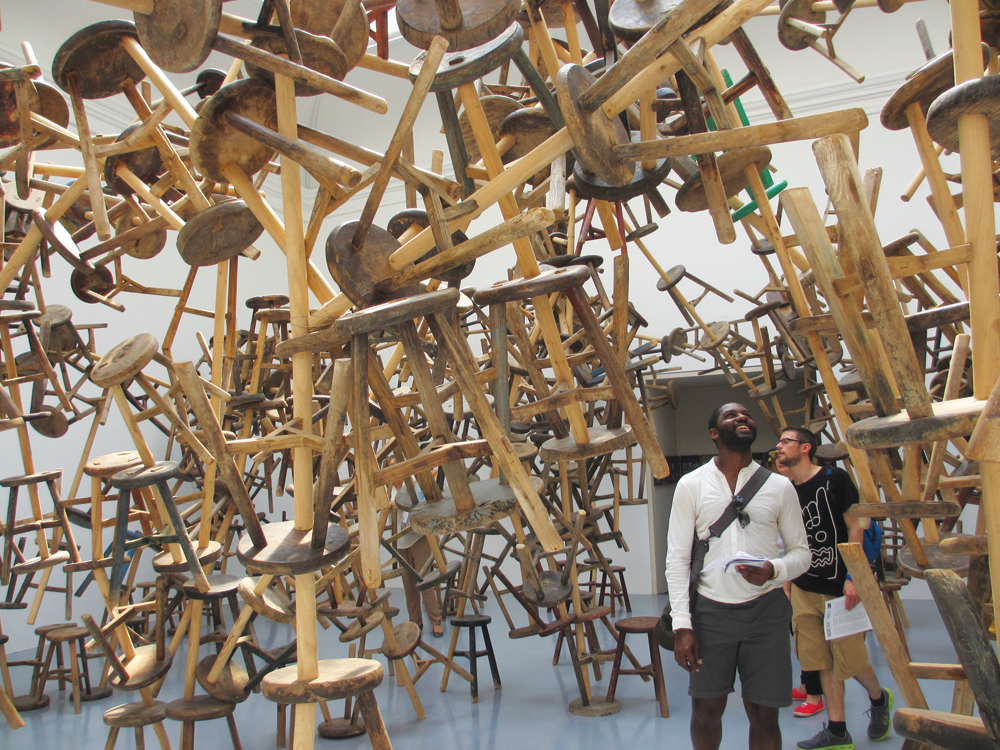
IDSVA student Whitney Hunter at the Ai Weiwei exhibit, Venice Biennale 2013. Photo: Michelle Perkins.
S.K.-I am intrigued by your concept of artist/philosopher. Would you unpack that for us?
G.S.-Artist-philosophers have always been with us in the world. As a matter of course, the Classical Roman poet Lucretius calls himself a philosopher in his poem “On the Nature of Things.” And long before Lucretius, Plato earned his still-standing title as the greatest artist-philosopher of all-time. But in fact, all the great philosophers have been artists, and all the great artists have been philosophers.
Bergson makes the dubious distinction that artists are “unintentional” philosophers; whereas, it is fair to say that most of the philosophers who aestheticize philosophy, certainly Hegel, Nietzsche, Heidegger, Derrida, Irigaray, and Kristeva, do so deliberately as a way of recuperating the truth of philosophy from the specialization of science-what Heidegger calls “Cybernetics.”
The problem of specialization begins with modernism, say, with Kant’s Third Critique. But the modernist prying loose of art from philosophy as a function of specialization is immediately countered by assertions such as the following: “Until we make ideas aesthetic, that is mythological, they are of no interest to the people, and vice versa: until mythology is rational, it will be an embarrassment to philosophy.”
Hegel, Hölderlin, and Schelling co-signed this manifesto in 1796. They believed-really, really believed!-that only the artist-philosopher could save us from ourselves: “Only then will equal development of all our powers await us, for the particular person as well as for all individuals. No power will again be suppressed, then general freedom and equality will reign among spirits!-A higher spirit, sent from heaven, must found this new religion among us, it will be the last, greatest task of humanity.”
And nobody believed these three artist-philosophers more than Heidegger. Aside from Hölderlin, Heidegger’s favorite artist-philosopher was Cézanne, who inspired Heidegger to write the poem “Cézanne.” The poem ends with the classically Heideggerian question,
Is a path revealed here, which leads to
A belonging together of poetry and thought?
My personal favorite artist-philosopher is Agnes Martin. But it is rare that an artist can rise to her level of philosophical judgment without the support of a community and a faculty, a school and a curriculum. IDSVA fills that void. Why? Because artists ought to have such a place. And because we are desperate for a world in which the Agnes Martins are not rare but more common than the evil banality that ever-increasingly determines our future conditions of existence.
NOTES
1. James Elkins presents a complete list of PhD programs for artists at tinyurl.com/m5jjyak
Stephen Knudsen is an artist and a professor of painting at Savannah College of Art and Design. He is the senior editor of ARTPULSE, a contributing writer to NY Arts Magazine, Hyperallergic, the SECAC Review and The Huffington Post, and the senior editor of the anthology The Art of Critique, which will be published in 2014.

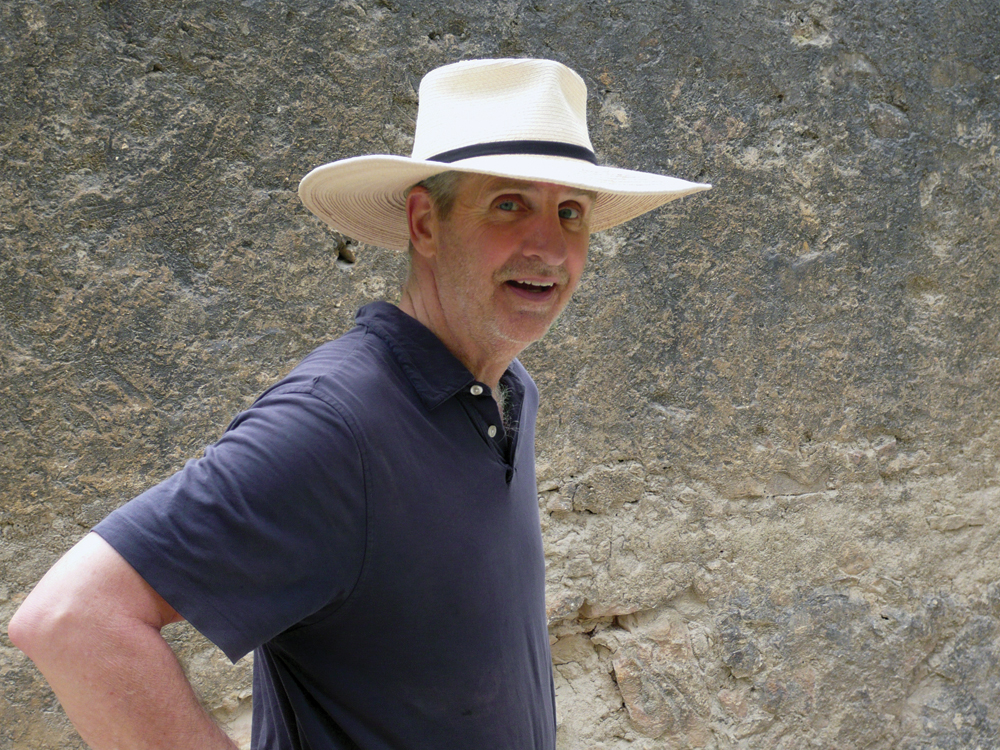
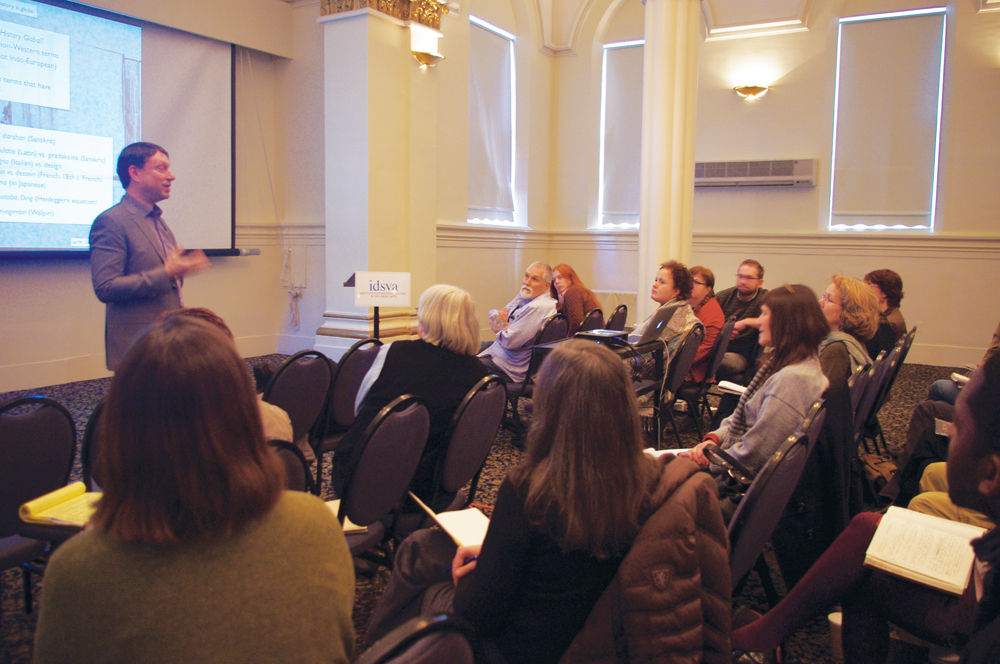
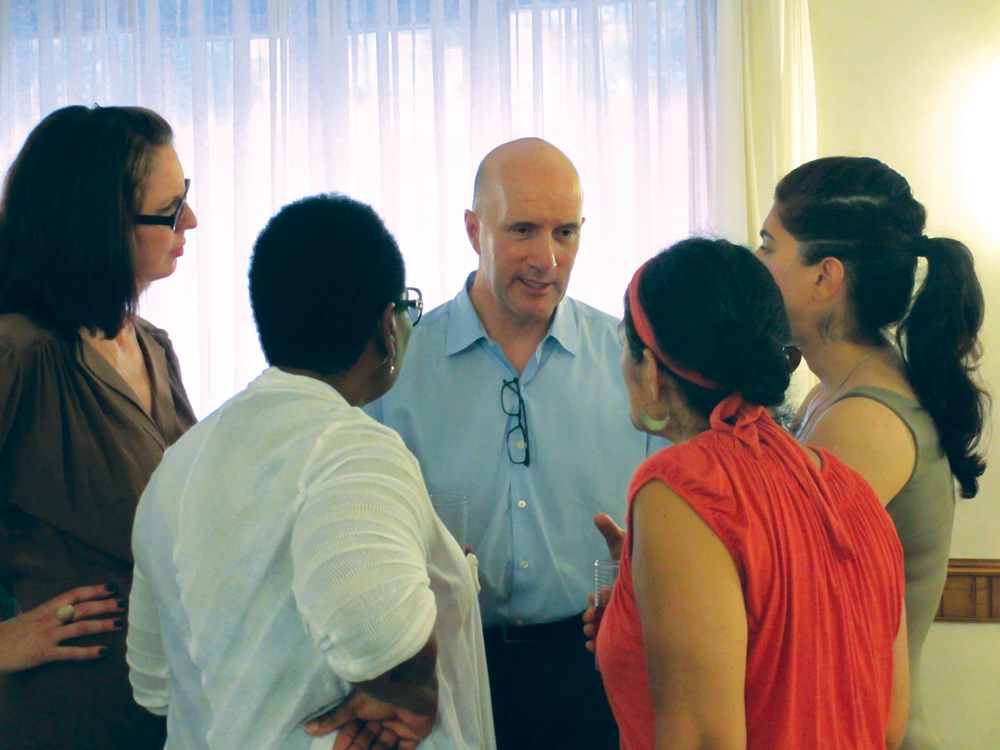
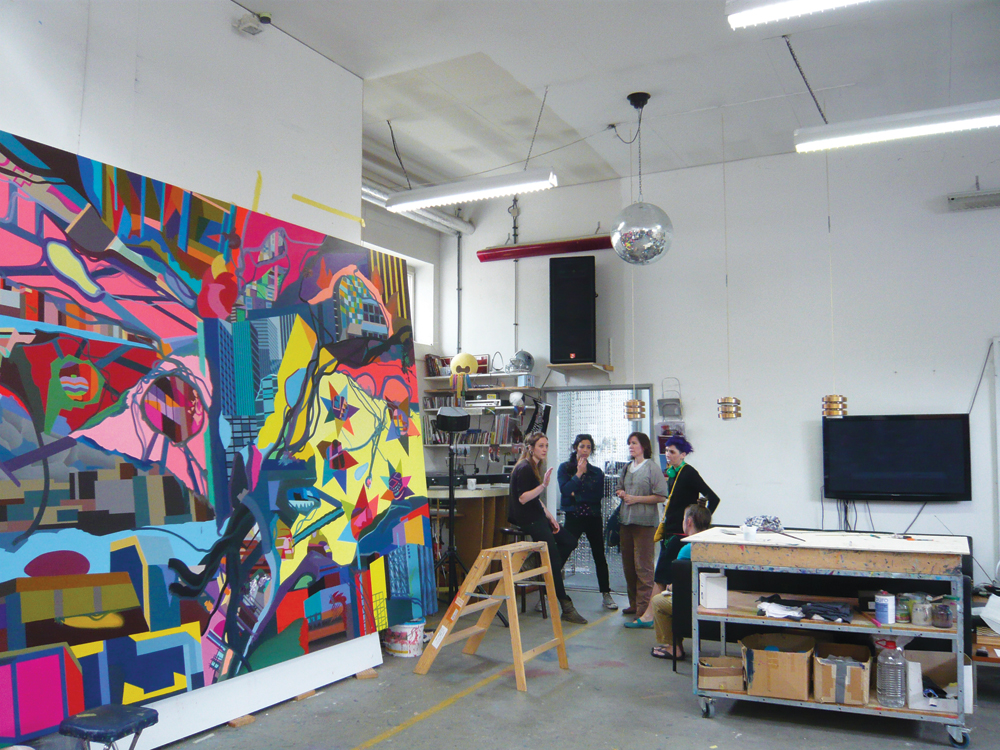


































Leave a Reply
You must be logged in to post a comment.